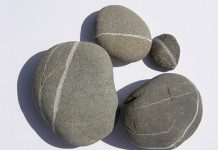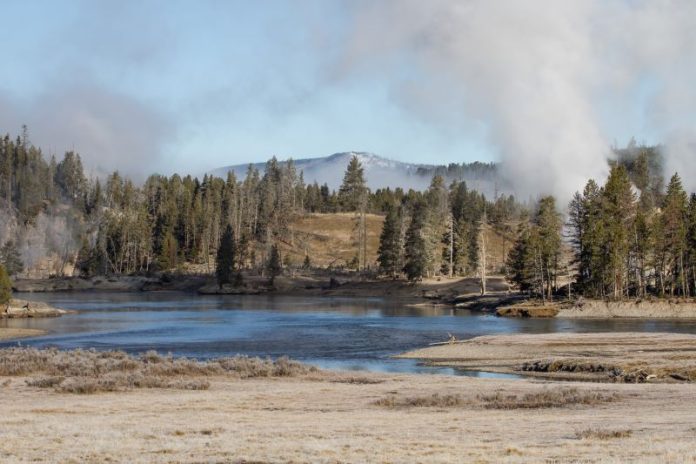
The Yellowstone volcano inevitably brings up the question of doomsday headlines about the exploding back to life. It’s the stuff of horror films and clickbait, but is it real?
The answer is, yes and no. The Yellowstone volcano is real with a dynamic history of earth-shaping events, including the massive caldera that stretches 50 x 40 miles in the central region of the park. However, despite holding half of the earth’s geysers and thermal features, another Yellowstone volcano explosion is not likely.
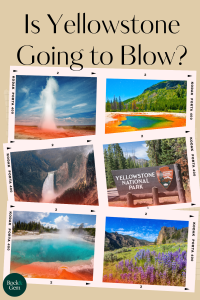
The Yellowstone Region
“The Yellowstone hotspot itself has been active around 50 million years, with intermittent volcanic activity that has left a trail across the western United States,” explains Michael Poland, scientist-in-charge of the Yellowstone Volcano Observatory (YVO) in Vancouver, Washington. Poland compares the Yellowstone region to similar volcanic chains like the one underwater below Hawaii. To paint a picture of what’s happening in this subterranean world, he recommends picturing an iron plate which represents the tectonic plates of the earth, then picturing the plate sliding slowly over the top of a blow torch which represents the plumes of heat rising from within the earth.
“As the plate moves across the stationary hotspot, the plume of heat breaks through, creating these chains of volcanoes,” he says.
It’s easy to picture Hawaii in this manner, as well as similar volcanically created island systems, and Poland points out, “Yellowstone is the same thing.”
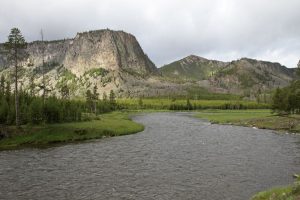
Photo by NPS/Jim Peaco
It Began in the West
While we often hear about the Yellowstone volcano as people point to the caldera on the map, in reality, this process began much farther west. Poland notes it all started off the coast of north California and southern Oregon. As the North American tectonic plate moved west, it caused the track of volcanism to migrate east, toward northern Nevada. “Then it went quiet for about five million years,” he says.
Approximately 16.7 million years ago, a huge outpouring of lava from deep within the earth began. This created what we now know as the Columbia River Basalt, including what we see at the Columbia River Gorge.
“The first of this chain of calderas formed at about that time,” he says. The McDermitt Caldera, located west of McDermitt, Nevada, is the first in the sequence of volcanoes that leads to Yellowstone. Poland also points out that there is a scar that originates in southern Idaho and leads to Yellowstone. In this region, the Snake River Plain was filled with sediment and lava following large explosive eruptions as the system appeared to move east.
Activity in Yellowstone
This activity reached the Yellowstone area 2.1 million years ago with the first significant eruption near Island Park, Idaho. The next major explosive event occurred 1.3 million years ago near Henry’s Fork in southeastern Idaho, and the famed Yellowstone caldera came to being a mere 631,000 years ago. Before and after these major explosive events there are lots of smaller eruptions that create lava flows.
“What you are seeing now is the current status of this long-lived course of events,” he says.
“It’s marching across the land. Geologically, (the Yellowstone caldera) is very young, but it has all of these siblings that get older as you go to the southwest.”
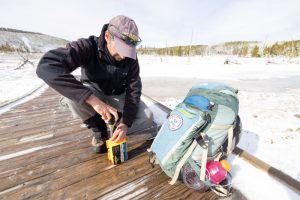
Photo by NPS / Jacob W. Frank
Role of Scientists
“We, as geologists, focus on the geological history of the region. It’s a detective story,” he explains. “When we look at the geological deposits left by this eruption, we can learn more about how they occurred.”
Poland says by studying the ash layers, they’ve noticed breaks within the deposits. “This suggests that these eruptions are not single huge events, but might actually be made of multiple, still large eruptive episodes,” Poland says. He also mentions that Montana State University is finding deposits that don’t fit the standard hypothesis while mapping one section of the caldera.
“(The eruptions) are not as simple as they are portrayed to be,” he says.
Monitoring the Ground & Water
To remain abreast of what’s happening beneath the surface, scientists monitor the ground and water throughout the park.
“People have been studying water and gases at Yellowstone for over 100 years.” Poland says, “The chemistry of the springs helps to figure out what is going on below ground. Magma is full of dissolved gases, and all of the bubbles want to get out. If there’s a new pulse of fresh (magma), some of the gases might show up in the hot springs.”
To keep an eye on these chemical fingerprints, numerous sensors offer realtime information on the water chemistry within the park. “Every few years scientists go to every major thermal feature. The geochemists take mule pack trains into the remote areas of the park and conduct these tests on the ground,” says Poland.
The Mud Volcano area is one of the most active regions, as far as magmatic gases go, within the park. Poland says it’s difficult to know what exactly is happening below the surface, although it might be because the ground composition offers a path of least resistance, permitting gases to escape. “For whatever reason the Mud Volcano area has all the right conditions.”
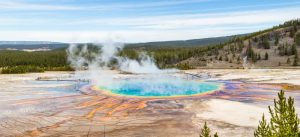
Photo by NPS / Neal Herbert
If the Ground Shakes, is an Eruption Imminent?
Besides keeping an eye on the waters of Yellowstone, scientists also monitor how the earth moves, which is Poland’s specialty at the YVO. He says there are different styles of earthquakes and each one offers scientists different information, such as whether there is water, magma or gas moving below the surface, depending on the pattern of the movement.
Earthquakes are nothing new to the Yellowstone area, which usually experiences between 1500 to 2500 every year. Poland says 99 percent of the time nobody feels them, but once in a while, a few magnitude 3.0s might catch people’s attention.
He points out that the largest earthquake in the Intermountain West of the United States was the 7.3 magnitude quake that originated approximately 6.5 miles west of West Yellowstone and formed Earthquake Lake in 1959. On June 30, 1975, there was a magnitude 6.0 in the Norris Geyser Basin area. “It’s kind of the forgotten earthquake,” he says.
The 1975 earthquake was the strongest recorded within Yellowstone, and while it toppled a few chimneys and blocked traffic with several rockslides, its effects were mostly felt deep within the earth.
Poland says, “Geysers are fragile. They don’t like to be shaken. After the 1975 earthquake, they saw a lot of changes within the thermal features in the park.” It’s noted that the time for Old Faithful Geyser increased by three minutes, plus thermal features changed in the Norris Geyser Basin area and nearby rivers exhibited more sediment in their waters.
Yellowstone Volcano On the Brink?
But just because Yellowstone is a hotbed for earthquakes and is one of the most thermally active places on earth, doesn’t mean it’s on the brink of a massive Yellowstone volcano explosion.
“These earthquakes are not related to the volcano,” he says. “It’s a very noisy area when it comes to earthquakes, but that doesn’t mean it’s about to erupt.”
Volcanoes have personalities that scientists focus on understanding to know when there is an issue. Even though people point to these earthquakes as signs of imminent danger, in reality, scientists might only raise their eyebrows if there are changes in the long-term pattern of the earthquakes. That could reflect the motion of magma below the surface. But there are better telltale signs.
“If you’re pushing magma through a crack, you’ll see ground deformation,” Poland explains.
“In Yellowstone, the ground rises and falls maybe an inch or two in a year.” That is within the normal boundaries, but if an area suddenly increases a foot or so within the same amount of time, scientists would take notice because it might mean that magma is moving closer to the surface and could be a sign of a volcano charging.
“We can see the signs. That’s why we spend so much time monitoring volcanoes,” he says. Yet, as far as Yellowstone goes, “It’s sitting there happily percolating along.”
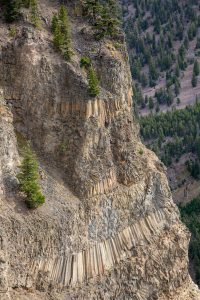
Photo by NPS / Neal Herbert
What a Yellowstone Eruption Looked Like
While most of us picture a spectacular explosion, similar to Mount St. Helens in 1980, Yellowstone behaves differently. “More often, Yellowstone erupts in lava flows,” he says, “and because it’s a relatively low-temperature lava flow, granted this is still 900°C, it looks far different than the glowing orange lava typically envisioned as part of a volcanic eruption.”
“It’s coming out like a solid mass. It looks like rubble coming across the landscape. It’s gray-looking rocks, sort of tumbling around,” he says.
The area around Old Faithful, particularly the higher ground around the Upper Geyser Basin, as well as Madison Junction, the Firehole area of the Nez Creek flow, and driving into the park from West Yellowstone, are all equally good examples of the result of these flows. There have been 20 to 30 lava flows since the explosion 631,000 years ago with the last one occurring approximately 70,000 years ago.
“By studying the geology we know that they happen in pulses,” as Poland points out there is one lava layer on top of another, and then there’s a gap. “We’re in a gap.”
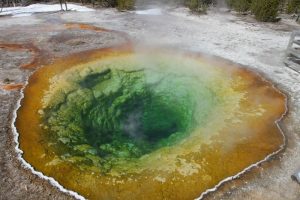
Photo by NPS/ Jim Peaco.
Yellowstone Volcano – Should We Be Afraid?
“I’ve been contacted by many people who have honest fears about Yellowstone,” Poland says. “In my lifetime, it’s very very unlikely to experience a volcanic eruption, and certainly not a major explosive event. What bothers me about pushing this narrative that it could erupt at any moment is that it’s a bit dishonest. Why do we have to sell Yellowstone in such a way?”
Known as ‘Wonderland’ in the early days of Yellowstone’s designation as a national park, naturalists, scientists and curious visitors alike explored the park to experience the thermal marvels first-hand. As early as 1871, geologist Ferdinand Hayden led an official expedition to study this almost mythical landscape adding credence to stories told by indigenous people and mountain men. Within a century, important scientific discoveries sprang from Yellowstone’s unique qualities, including the Polymerase Chain Reaction (PCR) test we all know so well, which originated from a microorganism found in a hot spring in 1966.
In a somewhat joking manner, Poland reminds us, “The surest sign that Yellowstone is fine is geologists are not going bananas.” Rest assured, if there was anything major happening, scientists would descend upon Yellowstone in droves.
With the multitude of wonders Yellowstone offers, the outrageous headlines warning of an apocalyptic Yellowstone volcano explosion are not only unwarranted, but they do no justice to this breathtaking spectacle. We can appreciate the marvel of the volcanic origins when we visit Yellowstone with the assurance that we will never be part of an action movie plot.
This article about the Yellowstone volcano previously appeared in Rock & Gem magazine. Click here to subscribe. Story by Amy Grisak.




